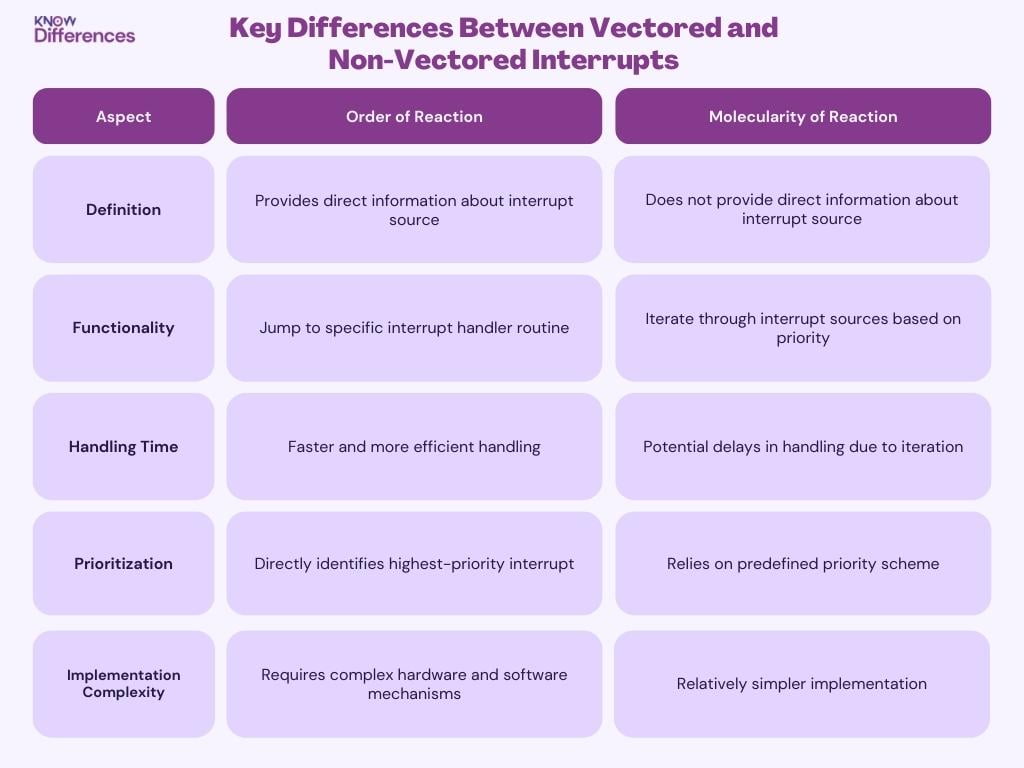In the realm of computer systems and microprocessors, interrupts play a vital role in managing and responding to external events. Two common types of interrupts are vectored interrupts and non-vectored interrupts. Understanding the difference between vectored and non-vectored interrupts is crucial for system designers and programmers to ensure efficient and effective interrupt handling. This article will delve into the nuances of vectored and non-vectored interrupts, shedding light on their definitions, functionalities, and key differences.
Table of Contents
What are Interrupts?
Interrupts are signals generated by hardware devices or software programs to temporarily pause the normal execution of a processor and divert its attention to a specific task or event. Interrupts allow for real-time responsiveness, enabling the processor to handle time-sensitive operations or events promptly. When an interrupt occurs, the processor suspends its current tasks, saves its state, and jumps to an interrupt handler routine to perform the necessary actions.
Vectored Interrupts
Vectored interrupts are a type of interrupt mechanism where the interrupting device or program directly provides the processor with information about the specific interrupt source. The interrupt vector, which is a unique identifier, helps the processor identify the appropriate interrupt handler routine to execute. In vectored interrupt systems, the processor can determine the interrupt source without the need for additional polling or investigation.
Non-Vectored Interrupts
Non-vectored interrupts, also known as basic interrupts, do not provide direct information about the interrupt source. When a non-vectored interrupt occurs, the processor relies on a predefined priority scheme to determine which interrupt handler routine to execute. The processor typically iterates through each interrupt source in a fixed order until it finds the highest-priority interrupt that needs attention.
Here’s a comparison table summarizing the key differences between vectored and non-vectored interrupts:
| Aspect | Vectored Interrupts | Non-Vectored Interrupts |
|---|---|---|
| Definition | Provides direct information about interrupt source | Does not provide direct information about interrupt source |
| Functionality | Jump to specific interrupt handler routine | Iterate through interrupt sources based on priority |
| Handling Time | Faster and more efficient handling | Potential delays in handling due to iteration |
| Prioritization | Directly identifies highest-priority interrupt | Relies on predefined priority scheme |
| Implementation Complexity | Requires complex hardware and software mechanisms | Relatively simpler implementation |
Key Differences Between Vectored and Non-Vectored Interrupts
Definition and Functionality
Vectored interrupts provide explicit information about the interrupt source through interrupt vectors. This allows the processor to directly jump to the appropriate interrupt handler routine, saving time and reducing overhead. Non-vectored interrupts, on the other hand, rely on predefined priority schemes to determine the appropriate interrupt handler routine. They do not provide direct information about the interrupt source, requiring the processor to iterate through the interrupt sources to find the highest-priority interrupt.
Handling and Prioritization
In vectored interrupt systems, the interrupt handling process is typically more efficient and faster. The processor can immediately identify the interrupt source and execute the corresponding interrupt handler routine. In contrast, non-vectored interrupt systems require additional time to iterate through the interrupt sources, potentially causing delays in interrupt handling. However, non-vectored interrupts allow for more flexibility in prioritizing different interrupt sources based on predefined schemes.
Implementation Complexity
Implementing vectored interrupt systems generally requires more complex hardware and software mechanisms. The interrupting devices or programs need to provide interrupt vectors, and the processor needs to have the capability to handle and process these vectors efficiently. Non-vectored interrupt systems, on the other hand, are relatively simpler to implement since they do not require interrupt vectors. However, designing a proper priority scheme for non-vectored interrupts can still be a challenging task.
Importance of Choosing the Right Interrupt Mechanism
Choosing the appropriate interrupt mechanism, whether vectored or non-vectored, is crucial for system designers and programmers. The selection depends on factors such as system requirements, real-time responsiveness needs, hardware capabilities, and software complexity. Understanding the differences between vectored and non-vectored interrupts allows for informed decision-making to ensure optimal interrupt handling and system performance.
Conclusion
In conclusion, vectored interrupts and non-vectored interrupts are two distinct mechanisms for handling interrupts in computer systems. Vectored interrupts provide direct information about the interrupt source through interrupt vectors, enabling efficient and fast interrupt handling. Non-vectored interrupts rely on predefined priority schemes and do not provide explicit information about the interrupt source. Both mechanisms have their advantages and considerations, and choosing the appropriate interrupt mechanism depends on the specific system requirements and constraints. By understanding the differences between vectored and non-vectored interrupts, system designers and programmers can make informed decisions to ensure smooth and efficient interrupt handling in their systems.

